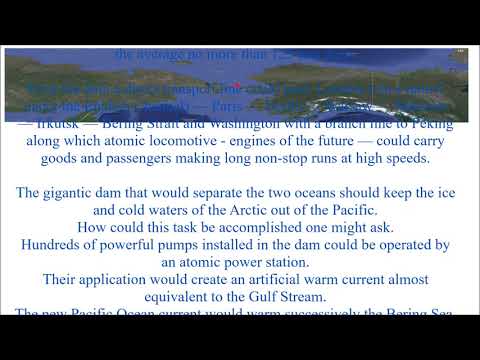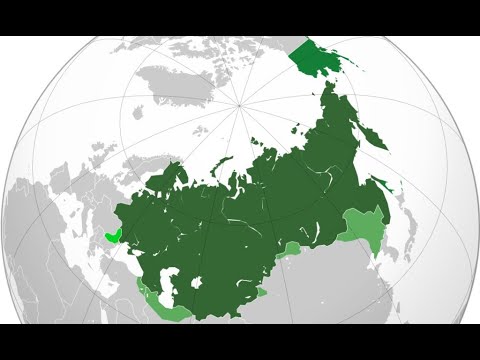ATOMIC POWER STATION (info from 1963 Y)
Music by Ilia Gvadzabia Video by Teona Gvadzabia #თეონა21 #Teona21 facebook.com/Teona21 E-mail: [email protected] Source: Э.Я.БАГ; Н.А.НЕЧАЕВА; Э.С.ЯРАЛОВА; 1963 Y. ATOMIC POWER STATION (info from 1963 Y) Industry depends on power. The industrial development of the last 200 years has been based primarily on the exploitation of coal and later on oil. In some parts of the world the force of flowing water has been used to generate electricity. Now a new fuel and a new source of power is put to the service of mankind. The fuel is uranium and the source of power is atomic power. The world first atomic power station was put into operation in the Soviet Union in 1954. This has shown not on paper, not by a laboratory model, but on an industrial scale that scientists and engineers have found ways to add to the world’s store of wealth a new source of useful energy. Nuclear power plants offer a new means of making power available in regions where the cost of transport is nearing its economic limits. One of the great advantages of atomic power stations is the fact that they can be built in the very region where power is to be used. As a result, long electric transmission lines become unnecessary. Atomic power stations are advantageous because of their low fuel consumption. If the capacity of an atomic power station is assumed to be one million kilowatts and its efficiency 25 per cent, only about 500 kg of fuel will be required to ensure the operation of the reactors for 24 hours. A power station of the same capacity operating with ordinary solid fuel would require 550 carloads of brown coal for the same period of time. The Soviet Union has plans for nuclear power plants in progress and it is scheduled to build different types of reactors. The total capacity of atomic power plants to be constructed under this program will range from two to two and half a million kilowatts. This represents some two or three times the planned atomic-power capacity in Britain or in the United States. The efficiency of the power stations in question is supposed to amount to 34 per cent, which corresponds to the efficiency of large modern power stations consuming solid fuels. Soviet scientists have designed a few types of reactors. One of them is to operate with a mixture of natural and enriched uranium. Atomic power plants will meet the ever-increasing demand for power by using a new source of energy, a source allowing the great industrial systems to continue hundreds — even thousands of years beyond the time when the conventional sources of power will have been exhausted.
Hubble G-ის სხვა ვიდეოები

გალაკტიონ ტაბიძე - ბედისწერა
 03:59
03:59
პატარა ლურჯი მანქანა (საბავშვო)
 00:33
00:33
ბრძნული გამონათქვამები, სამოტივაციო ვიდეო 1
 03:40
03:40
ლექს სენი - ხედავდი / Lex-seni - Khedavdi
 02:53
02:53
ტარიელ ბერაძე (ქალაქ თბილისის არამ ხაჩატურიანის სა...
 02:03
02:03
ჩემი შთაბეჭდილება რუსთაველის თეატრის მიმართ. სპექტ...
 00:28
00:28
გილოცავთ ქალთა საერთაშორისო დღეს, 8 მარტს! #თეონა...
 03:30
03:30
ოქროს ულვაში, სახლის ჟენშენი, ვენერას თმა, სურნელო...

მსგავსი ვიდეოები

BETWEEN TWO CONTINENTS (1963 Y)
Hubble G

5 cosas ASOMBROSAS que puedes hacer en Fallout 4part 2
Ollie Felix

400 Georgian Generals of the Russian Empire
Tornike Pkhaladze

125 Georgian Generals of the Soviet Union
Tornike Pkhaladze

წიგნი, რომელმაც შეცვალა ჩემი ცხოვრება || Atomic Habits
Giorgi Odishvili

Cast of TVD read your social media reactions (ქართული სუბტიტ...
ATOMIC CAT GAMER
![The Vampire Diaries 7x01 Webclip [ქართული სუბტიტრები]](https://i.ytimg.com/vi/YQZ7X96lsIc/hqdefault.jpg?sqp=-oaymwE1CKgBEF5IVfKriqkDKAgBFQAAiEIYAXABwAEG8AEB-AH-CYAC0AWKAgwIABABGHIgTCgsMA8=\u0026rs=AOn4CLA83RK88wLxS7YzS8RrouH_I64EZg)
The Vampire Diaries 7x01 Webclip [ქართული სუბტიტრები]
ATOMIC CAT GAMER

chris wood საუბრობს წვიმაში კოცნაზე – ქართული სუბტიტრებით
ATOMIC CAT GAMER